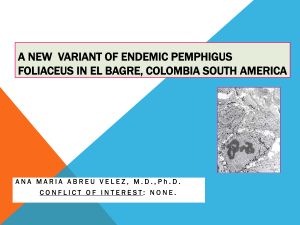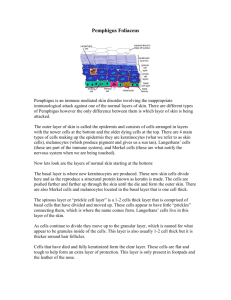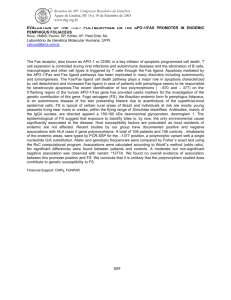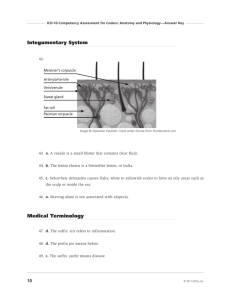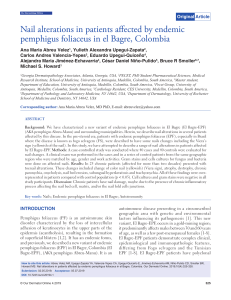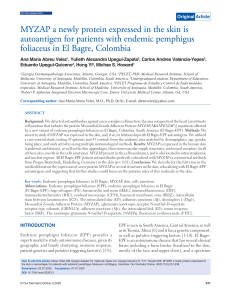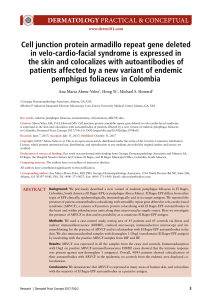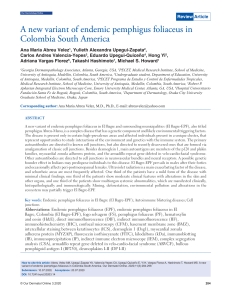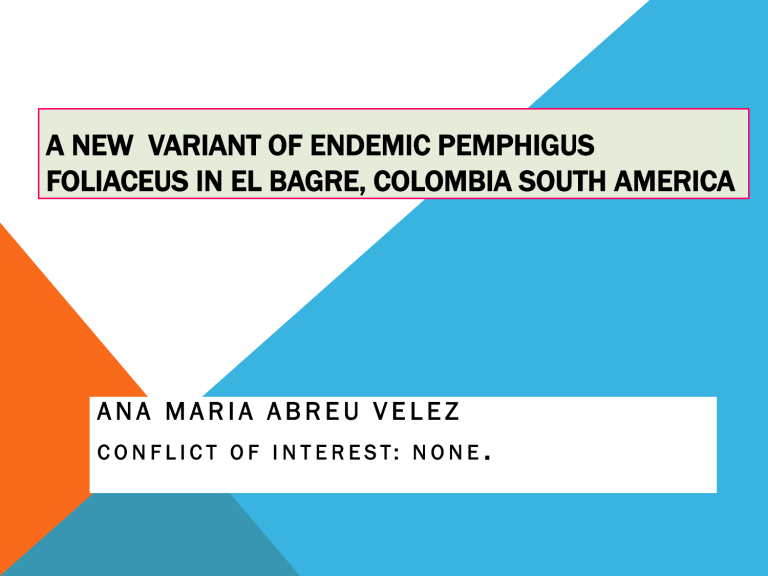
A NEW VARIANT OF ENDEMIC PEMPHIGUS FOLIACEUS IN EL BAGRE, COLOMBIA SOUTH AMERICA ANA MARIA ABREU VELEZ C O N F L I C T O F I N T E R E S T: N O N E . WHAT IS ENDEMIC PEMPHIGUS FOLIACEUS? Pemphigus foliaceus is an autoimmune skin disease mediated by autoantibodies against mainly against desmoglein 1 (Dsg1). The endemic form is thought to have an environmental cause. Normal subjects living in an endemic area have antibodies against (Dsg1). ENDEMIC PEMPHIGUS FOLIACEUS Endemic foci of fogo selvagem (FS) are almost exclusively located in rural areas of Brazil. People of many races and ethnic groups are affected, including Brazilians of Portuguese, Spanish, German, African, and Japanese descent who live in the endemic areas. The incidence of FS decreases dramatically as a region becomes urbanized.. ENDEMIC PEMPHIGUS FOLIACEUS These findings support the concept that the production of antibodies against desmoglein 1 is initiated by exposure to an unknown environmental agent. There are two forms of pemphigus foliaceus: a none endemic form, first described in Paris in 1844, that occurs throughout the world, and FS (endemic form), that was first reported in Brazil around 1903. Other endemic foci have been reported in Colombia, Peru, Venezuela, Salvador, and Tunisia. ENDEMIC VERSUS NON-ENDEMIC PEMPHIGUS The endemic and none endemic forms of the disease are clinically, histologically, and immunologically similar, but several features are unique to the endemic form, such as the geographic, temporal, and familial clustering of cases, the higher frequency of cases among children and young adults than among older persons, and an association with certain HLADR alleles. A NEW VARIANT IN EL BAGRE, COLOMBIA, AKA PEMPHIGUS ABREUMANU THAT CLINICALLY RESEMBLES SENEAR-USHER SYNDROME Fogo selvagem, most frequently resembles pemphigus foliaceus (PF). It primarily affects children and young adults, with the highest incidence rates occurring in the 10 - 30-year-old age group. The incidence in men and women appear to be similar. Furthermore, Brazilian cases tend to be clustered in specific families residing in rural areas, especially in workers for road construction and agriculture. GEOGRAPHIC LOCALIZATION ENDEMIC AREA THE SENEAR USHER FORM LIKE LUPUS SOME CLINICAL FORMS SOME ATYPICAL CLINICAL LESIONS ENVIROMENT TESTING FOR AUTOANTIGENS USING A BACULOVIRUS EXPRESSION SYSTEM IMMUNOPRECIPITATION IMMUNOBLOTTING USING DIFFERENT CELLS EXTRACTS EXIKFAAAXREGED IMMUNOBLOTTING USING ECL DEVELOPMENT OF AN ELISA USING COW SNOUTS SEQUENCE ANALYSIS BY MASS SPECTROSCOPY We obtained 9 pg. of the 48kDa band (PF antigen) from 14 cow snouts. Although the 48 and the 45 kDa bands comigrate closely, we only excised the 48kDa since it co-migrate with the radiolabelled antigen. This band was subjected to N-terminal protein sequence analysis. An N-terminus sequence EXIKFAAAXREGED 1.2 0.8 0.4 OD 492 nm (Linear scale from 0.0 to 1.4 units) COMPARING FS AND EL BAGRE-EPF AUTOANTIBODIES USING TWO ELISAS Cut-off value 0.0 CPF FS NHS PE BP PV SLE EPF DEA GROUPS OF DONORS DETECTION OF AUTOPANTIBODIES USING TWO DIFFERENT ELISAS 1.5 1.0 (r2=0.92) 0.5 OD 492nm (Linear scale from 0.0 to 1.4 units ) ASSESSMENT BETWEEN CLINICAL DISEASE ACTIVITY FOR SKIN AND OD 492 READINGS 0.0 0.0 0.1 0.2 0.3 0.4 0.5 0.6 0.7 0.8 0.9 1.0 Skin surface compromised and dosage of steroid hormones in patients with endemic pemphigus foliaceus from El Bagre DIF AND IIF ON MONKEY ESOPHAGUS HISTOLOGICAL PATTERNS SUMMARY: EYES, MEIBOMIAN GLANDS, TARSAL MUSCLE, CONJUNCTIVA, PACINIAN CORPUSCLE, OPTIC NERVE (LEPTOMENINGES) EYES, MEIBOMIAN GLANDS, TARSAL MUSCLE, CONJUNCTIVA, PACINIAN CORPUSCLE OPTIC NERVE (LEPTOMENINGES) Newtonian secretion EYES, MEIBOMIAN GLANDS, TARSAL MUSCLE, CONJUNCTIVA, PACINIAN CORPUSCLE, OPTIC NERVE (LEPTOMENINGES) Pacinian corpuscle IN OUR STUDY OF EL BAGRE-EPF PATIENTS, THE PRESENCE OF HARDYWEMBERG LINKAGE DISEQUILIBRIA OF STRS FROM HLA II FAVORS THE LOCUS D6S291 FOR DISEASE SUSCEPTIBILITY, AND SUGGESTS A PROTECTIVE ROLE FOR LOCI D6S1019 AND D6S439 IN OUR CONTROLS. ASSOCIATED SHORT TAMDEM REPEATS (STRS) SOME OCULAR FINDINGS PACINIAN CORPUSCLES EYE FINDINGS Meibomian glands ductus Tarsal muscle EYE FINDINGS Meibomian glands CONFOCAL MICROSCOPY OF A NERVE CONFOCAL MICROSCOPY OF THE HEART EYE FINDINGS Skin BMZ and ICS Meibomian glands BMZ: Basement membrane zone, ICS, Intercellular stain between keratinocytes. OCULAR FINDINGS Newtonian secretion Sweat glands lipofuscin PACINIAN CORPUSCLE OCULAR FINDINGS Eyelid BMZ and ICS Muscle bundles OCULAR FINDINGS Meibomian glands OCULAR FINDINGS AUTOREACTIVITY TO MECHANORECEPTORS AUTOREACTIVITY TO MECHANORECEPTORS AUTOREACTIVITY TO MECHANORECEPTORS AUTOREACTIVITY TO NERVES AUTOREACTIVITY TO NERVES AUTOREACTIVITY TO NERVES AUTOREACTIVITY TO NERVES AUTOREACTIVITY TO NERVES PALMS PALMS AUTOREACTIVITY TO SWEAT GLANDS AUTOREACTIVITY TO SWEAT GLANDS INDIRECT IIF KIDNEY INDIRECT IMMUNOFLUORESCENCE ON KIDNEY INDIRECT IMUNOFLUORESENCE (IIF) ON KIDNEY IIF ON KIDNEY HEART REACTIVITY ELECTRON MICROSCOPY ELECTRON MICROSCOPY Trypsinize Bovine Epidermal Tissue Purify on Con A Column Patient serum linked to Protein A-Sepharose column Purify on Immunoaffinity Column Purify by SDS-PAGE
